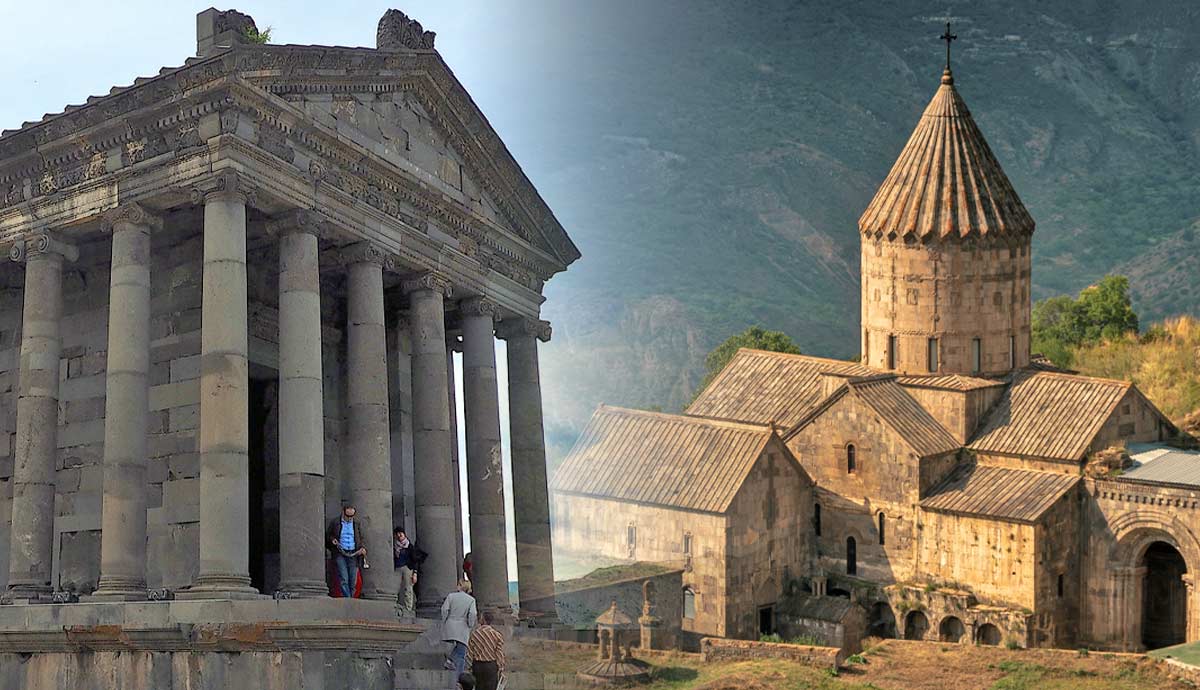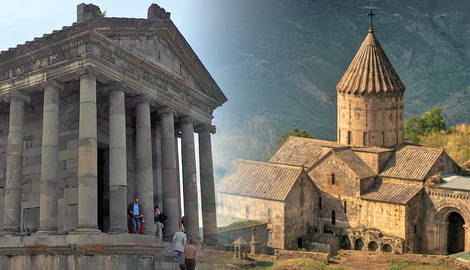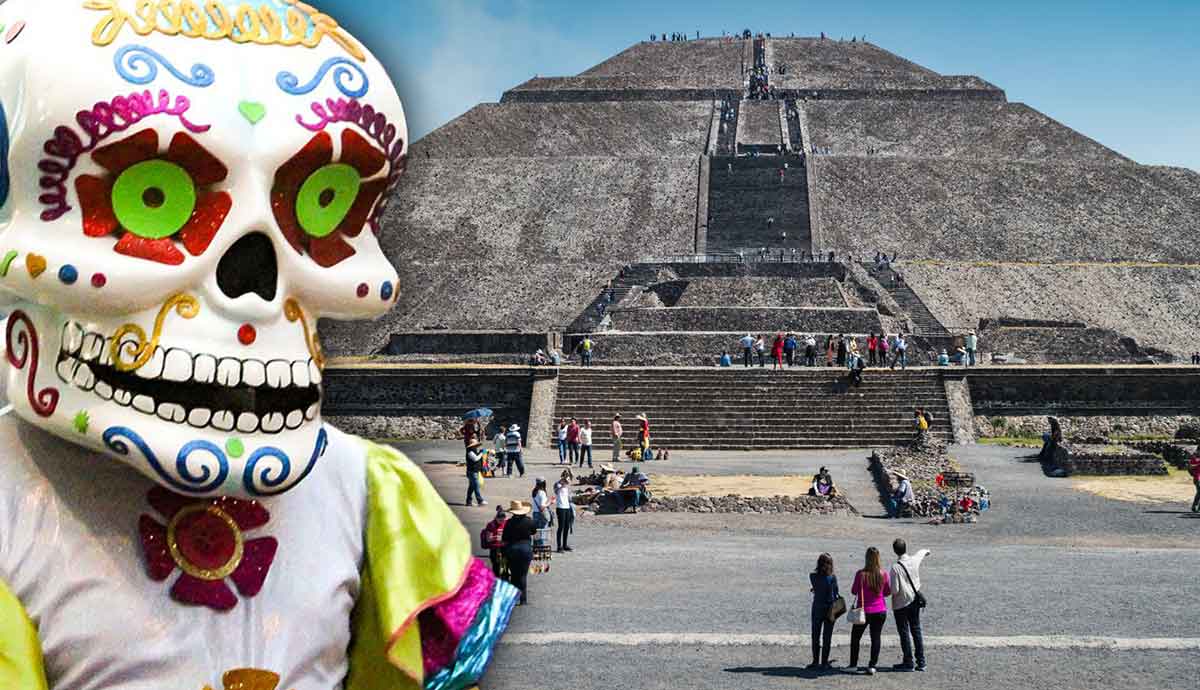
As the first country to adopt Christianity as a state religion, Armenia boasts the world’s oldest Christian churches and monasteries, all set in immensely picturesque locations. It was also subjected to seven decades of Soviet occupation and, due to its strategic location at the crossroads of Europe and Asia, has been at the center of conflict for millennia.
Despite its harrowing history, Armenia does a commendable job of protecting and showcasing its most important historical relics. When you visit Armenia, don’t miss these ten must-see historical sites.
1. The Armenian Genocide Museum, Yerevan

Considered the first ethnic cleansing of our modern era, the Armenian Genocide (1915–1923) was one of the devastating events that inspired Raphael Lemkin, a Polish-Jewish lawyer who contributed to the Nuremberg Trials, to coin the term “genocide” in 1944. Visiting the Armenian Genocide Museum is a profoundly moving experience and unmissable if you wish not only to understand more about Armenia’s fight for survival but also the genocide’s still-currant impact on the nation’s psyche.
The capital’s foremost history museum is well laid out in chronological order, beginning from the dawn of the 20th century. It retells the struggle of Armenians living as a Christian minority group within the Muslim-majority Ottoman Empire and the escalation of their oppression until the eventual attempt at their total annihilation.
The museum’s modern and solemn design houses a collection of photographs, documents, personal belongings, eyewitness accounts, and artifacts that provide a detailed account of the genocide. It is part of a memorial complex that includes a Soviet-era monument and an eternal flame commemorating the 1.5 million Armenians who perished during the genocide.
2. Mother Armenia Monument in Victoria Park, Yerevan

Sitting atop a hill overlooking central Yerevan, Victoria Park was first established in 1950 to commemorate Soviet victory in World War II. The park’s centerpiece used to be an imposing statue of Stalin, yet in 1967, it was replaced by a 72-foot copper statue of Mother Armenia. Tall, proud, and slightly antagonistic, Mother Armenia stands atop a pedestal housing the Military Museum of Armenia.
Astute visitors will undoubtedly notice that the statue is flanked by all manner of military paraphernalia (missiles, tanks, and jets), all pointed toward Turkey. Once you’ve visited the Armenian Genocide Museum, you will grasp the context.
The belvedere opposite the statue affords spectacular views of Yerevan and, in the distance, Mount Ararat. No longer Armenia’s tallest peak and its cultural pride and joy, Mount Ararat was lost to Turkey in the 1923 Treaty of Lausanne, something the country has never quite forgiven.
3. Garni Temple

Adopting Christianity as a state religion in 301 CE didn’t just signal the start of a new future for Armenia. It also spearheaded the destruction of its pagan past. Located amidst spectacular mountain scenery just 15 miles southeast of Yerevan, Garni Temple is a masterpiece of Hellenistic architecture and a must-see historical site in Armenia.
Built in the 1st century CE by King Tiridates I and dedicated to the sun god Mihr, Garni Temple is the most significant pre-Christian historical relic left standing in the country. Others are dotted across the Armenian landscapes, but since most are essentially reduced to piles of rubble, this is arguably the only one worth visiting.
The basalt structure features classic Ionic columns and intricate carvings and is perched on a rocky promontory overlooking the Azat River Gorge. The temple is eye-popping of its own accord, yet the views across the valleys and along the gorge—a geological wonder—are equally breathtaking.
Despite being partially destroyed by a 1679 earthquake, the Garni temple was meticulously restored in the late 1960s and early 1970s. Usually, a visit here is combined with a stop at our next historical highlight.
4. Geghard Monastery

Carved into the rockface of the Azat River Gorge, Geghard Monastery is a UNESCO World Heritage site renowned for its incredibly unique architecture and revered for its spiritual significance. Dating back to the 4th century CE, this complex of medieval churches and chapels is an enticing blend of natural and man-made beauty, unlike any other historical site in Armenia.
Plan to travel here on a sunny day, and you’ll discover intricate carvings, ancient chapels hidden in caves, and long and dark corridors drenched in natural light as they filter through the many stone-cut windows. Legend has it that the monastery once housed the spear used in Jesus’s crucifixion.
Visit on a Sunday, and you might also be lucky enough to hear the local all-female Gregorian chanting choir practicing their ethereal craft in the big oval chapel. It is worth noting that busloads of tourists on organized trips arrive at the site in the late morning when the light is “just right” for photography and after they’ve stopped in Garni. Big crowds can easily overwhelm a serene historical site like Geghard, so if you prefer a more peaceful visit, head here first and visit Garni on the way back to Yerevan.
5. Tatev Monastery

While even the most committed history lover risks suffering a bout of church burnout in Armenia (it is very much a thing here), visiting Tatev Monastery is a must. Located in the country’s far south, nestled in some of its most alluring mountainous landscapes, Tatev is perched atop a vertiginous cliff overlooking the Vorotan River Gorge.
Founded in the 9th century CE, Tatev swiftly became the most crucial religious learning center in medieval Armenia. It was a remote and isolated haven where monks and clergy meticulously copied and preserved religious texts, historical manuscripts, and literary works. They contributed to maintaining and disseminating Armenian culture and knowledge during medieval times.
From a historical point of view, Tatev wins prizes for seniority, being one of the oldest Christian complexes in Armenia. It also entices with its many relics, including impressive fortress walls, an ancient oil mill, a unique pendulous column, and awe-inspiring frescoes painted by European masters. Yet, one of the most alluring aspects of a visit is the chance to ride the longest reversible cable car in the world. Soak up eye-popping views of the gorge as you ascend the monastery directly from Halidzor village on the “Wings of Tatev.” Or, as the locals call it, the tramway to heaven.
6. Khor Virap

Located near the Turkish border, just south of Mount Ararat, Khor Virap is renowned for its pivotal role in converting Armenia to Christianity in the early 4th century CE. Here, Saint Gregory the Illuminator, the patron saint of Armenia, was imprisoned in a deep pit for 13 years by King Tiridates III. This dramatic episode not only solidified Christianity as the state religion of Armenia but also marked the beginning of a long and enduring Christian tradition in the whole Caucasus region.
The monastery’s stellar location offers unparalleled views of Mount Ararat, which holds symbolic importance in Armenian culture as the believed resting place of Noah’s Ark (hence the resentment about losing the peak to Turkey). Nowadays, Khor Virap remains an active pilgrimage site and is one of the most revered places of worship.
While the monastery itself may not be grandiose, you would be hard-pressed to find one with a more remarkable setting.
7. Lake Sevan and Sevanavank Monastery

Lake Sevan, one of the world’s largest high-altitude lakes and the largest lake in the Caucasus, holds a substantial place in Armenian history. It is home to the 9th-century Sevanavank Monastery, and the Sevan Lake Union of Writer’s House, an iconic symbol of the architectural style known as Soviet Brutalism. The lake is also a testament to what it almost became: one of many environmental disasters of the Soviet era.
During Soviet occupation (1920–1991), Lake Sevan was almost harvested into oblivion as extensive irrigation projects diverted water from its tributaries to support agriculture, drastically reducing its water level. Luckily, Sevan’s sheer size helped it endure long enough to see the fall of the Soviet Union and the start of concerted efforts to replenish its water and fish.
After a slow and steady recovery, Lake Sevan is now Armenia’s most prized asset. It is the country’s prime freshwater reservoir and most popular tourist attraction. The lake is also deeply embedded in local culture and folklore.
Due to its high altitude (6,234 feet), Lake Sevan welcomes spring quite late, around mid-June. Visiting this time of year will allow you to experience the explosion of scents and colors of the wild herbs and flowers all along its shores.
8. Orbelian Caravanserai

The Orbelian Caravanserais is one of the last remaining relics of Armenia’s role as a noteworthy stopover along the ancient Silk Road. Built in the 14th century CE, along a lesser-known route of the ancient trade line discovered by Marco Polo, Orbelian showcases intricate ornaments, carvings, and a chapel. You must have direct sunlight overhead to take in all the details. Alternatively, arm yourself with a headtorch before visiting.
Armenia’s best-preserved caravanserai (one of only four left (somewhat) standing in the country) Orbelian played a vital role in the evolution of the local culture. Not only did these ancient roadside inns facilitate the trade in goods between East and West, but they also helped the spread of philosophy, religion, and the arts between Asia and Europe.
You’ll find the Orbelian Caravanserai along the M10 road heading south toward the Iranian border, along a snaking road that affords astronomical views of the Vardenyats Mountain Range. Head here, and you’ll be in the heart of Armenia’s ancient winemaking region — one more reason to explore a little further.
9. Areni-1 Cave Complex

While in this stunning southern region of Armenia, visit the Areni-1 cave system, home to the world’s oldest known winery. This complex of caves dates back to 5000-4000 BCE and has revealed ancient winemaking equipment and even traces of red wine. Interestingly, the site also unearthed the oldest leather shoe, amazingly preserved for 5,500 years due to the cave’s dry, cool conditions and sheep dung insulation.
Additional archaeological finds at Areni-1 include well-preserved barley, wheat, apricots, and the world’s oldest brain tissue specimen.
10. Dilijan Old Town

Armenia’s answer to a picturesque Swiss village is located in the Tavush province northeast of the capital. Historic Dilijan is a breath of fresh charming air in a region that is often replete with drab-looking gray abodes. The town is renowned for its medicinal natural springs and surrounding wilderness, with a historic core comprising cobbled streets, stone houses, and wooden balconies. It is wonderfully preserved and represents perhaps the most enchanting example of Armenian traditional architecture.
Aside from offering easy access to two prominent medieval monasteries (Haghartsin and Goshavank), the town is also the central point of an eponymous national park prized for its biodiversity. Several hiking trails lead to ancient fortresses and Armenian khachkars (memorial cross-stones), all set within verdant forests. The park also hosts wildlife, including seldom spotted brown bears, Eurasian lynx, and gray wolves.










